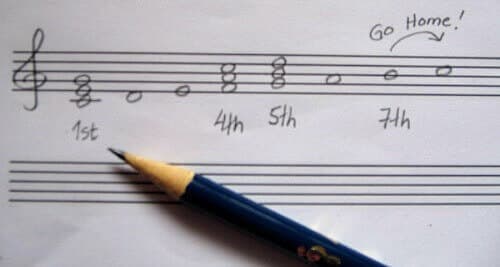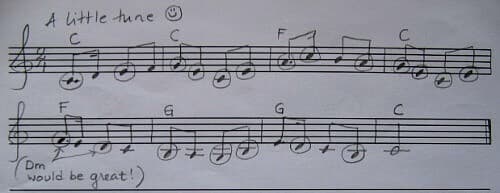- Home
- How to Write Music
- Chord Sequence
Add a Chord Sequence to a Melody
This article may contain compensated links. Please read the disclosure for more info.
How Do You Add a Chord Sequence to a Melody?
In this lesson for beginners, you'll learn how to find the chords and to add a simple chord sequence to accompany a melody.
How to Add a Chord Sequence
If you followed the first lesson in how to write music, you learned how to write a simple melody. Your little tune would be 4 or 8 measures long, so it is actually only a phrase (musical sentence) or two, yet.
But it is still fun to get a feel for how the music grows, and to get a taste for what is possible, so let’s learn how to add chords to a melody with a chord sequence!
Later you will see how this little phrase can become...anything!
The 3 chords that will fit your melody
By choosing a scale to write the melody with, you have actually already chosen your chords.
Chords can be built from each step of the scale, and all can be used for a melody that's using the same scale.
These chords are called diatonic harmony:
 Chords in a C major scale.
Chords in a C major scale.We only have to see where each chord fits best in the melody, and create a chord sequence, or chord progression that sounds nice.
However, since this is a first beginner’s lesson in how to compose music, we will only use 3 of the chords.
The most useful chords made from a major or minor scale are those built on the first (I), fourth (IV) and fifth (V) step of the scale.
These chords are also called:
- Tonic (I)
- Sub-dominant (IV)
- Dominant (V)
How to Find the 3 Chords/Triads
Here's how to find the chords you need.
- First; write your scale.
- Then on the first (I), fourth (IV) and fifth (V) note of the scale add two more notes a third apart to make triads, like in this example:
 Triads on the I, IV, and V steps of the scale.
Triads on the I, IV, and V steps of the scale.These are the 3 chords that we will use in this exercise. The chords on these steps in any scale are also called Tonic (I), Subdominant (IV) and Dominant (V).
In my example in C major (above) the chords are C major, F major and G major. Now we only have to figure out where they fit with the melody!
If you play piano or guitar is it simple. Play and sing the melody and keep testing to hear where the three chords fit. Done.
But in the following exercise you will learn how to do it without "help" from an instrument!
Decide the chord sequence
Now, in what order should the chords be?
The first chord to add is the easiest. It is also the last. The last chord of the piece should be a Tonic (I). This chord feels like «home» and is the best chord to finish a composition with.
The chord before that is often a Dominant (V), but we’ll see what fits our melody best first.
Let’s keep it simple.
We will add a chord only to the first note in each measure, unless you have a lot going on; then you might want to add two chords for each measure.
This is how to know where they fit
- What note is in the melody right where the chord should be added?
- Use the chord that contains that note.
- If there are more than one chord that fits, look at the neighboring notes of the melody. If there are more notes used from one particular chord, use that one.
Use I, IV, V
- It is also useful to know that right before a Tonic chord (I) it sounds great with a Dominant (V), if it fits the melody.
- And before the dominant chord it often sounds good with a Subdominant (IV). This gives you the standard IV-V-I cadence.
Keep it simple! As you learn more you can experiment with other chords, but for now just use the three basic triads (I, IV, V).
So for my example, I found this chord sequence fits the tune (the circled notes are also found in the chord). The chords are written as capitals above the melody:

As you can see sometimes the whole measure has all the notes of one of the chords, so it is easy.
But in the measure before the last I could use both a G and a C chord.
Since I know that it works great with a G chord (the Dominant, or V in C major) right before the last C chord (Tonic, or I chord in C major), since it gives the very plain but nice V-I chord sequence, I choose the G chord.
Try, and Try Again
Remember that you can always just try it by playing/singing and see how it fits, but it is kind of fun to see how well the musical composition will sound even if you wait without playing it as you write!
It is always such a pleasure to finally hear the result, and how amazing it sounds even by working only with these simple rules with only a pencil and staff paper!
Moving On
Once you find where the chords fit your melody, you have all you need to make a great arrangement.
Actually, it is great as it is too- sing the melody and play the chords with a guitar or a piano. Voila! But of course we will do more!
>>> Let’s go on to arrange your composition in 4-part harmony!





